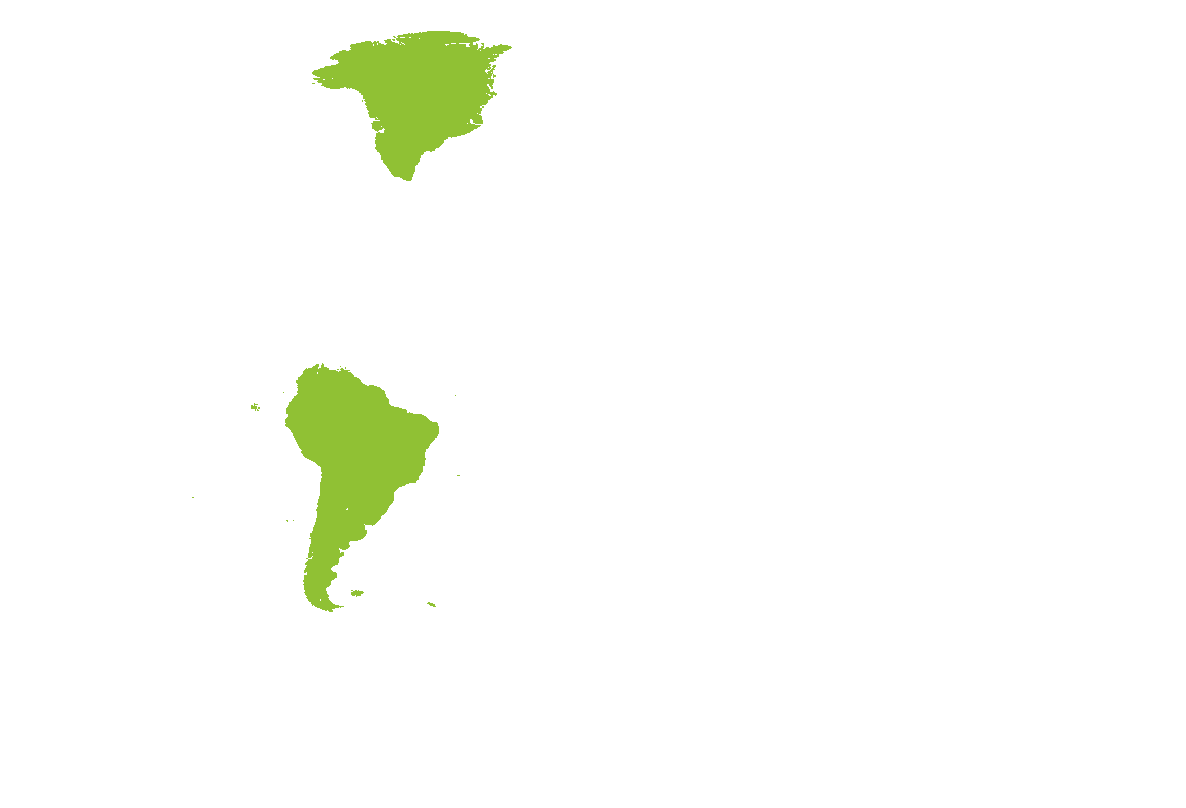Northern Greenland
A new five-year project aimed at drilling through the ice to the underlying bedrock in four areas of northern Greenland promises to reveal the ice sheet’s past in unprecedented detail and enable more accurate predictions of how it may add to rising seas in the 21st century.
CHINA
Dinosaurs Took Over Amid Ice, Not Warmth Two hundred million years ago, the Triassic-Jurassic Extinction killed off the big reptiles who ruled the planet, and apparently cleared the way for dinosaurs to take over. Why did dinosaurs thrive when other creatures died? Research led by Lamont's Paul Olsen presents the first physical evidence that Triassic dinosaurs regularly endured freezing conditions. Excavations in China's Junggar Basin revealed dinosaur footprints along with odd rock fragments that only could have been deposited by ice. During the extinction, cold snaps happening at the poles spread to lower latitudes, killing off the coldblooded reptiles. Dinosaurs, already adapted, survived and spread out. The rest is ancient history.
Dinosaurs Took Over Amid Ice, Not Warmth Two hundred million years ago, the Triassic-Jurassic Extinction killed off the big reptiles who ruled the planet, and apparently cleared the way for dinosaurs to take over. Why did dinosaurs thrive when other creatures died? Research led by Lamont's Paul Olsen presents the first physical evidence that Triassic dinosaurs regularly endured freezing conditions. Excavations in China's Junggar Basin revealed dinosaur footprints along with odd rock fragments that only could have been deposited by ice. During the extinction, cold snaps happening at the poles spread to lower latitudes, killing off the coldblooded reptiles. Dinosaurs, already adapted, survived and spread out. The rest is ancient history.
Photo: A feathered theropod dinosaur carries off a mammalian victim during a volcanic winter of the Triassic-Jurassic Extinction period.
Painting: Larry Felder
BANGLADESH
Land Subsidence and Earthquake Risk in Bangladesh
Across much of low-lying Bangladesh, sea levels have risen and the land is sinking, due to natural compaction of sediments. This can increase flood risk and pollution of fresh water aquifers. The region also faces the risk of an earthquake so catastrophic, it could change the course of rivers. Geophysicist Michael Steckler and colleagues are studying the forces at work here with very precise measurements of the underlying geology and changing land levels. Their findings will help in the design and maintenance of the many embankments keeping the sea at bay, and will improve mapping of seismic hazards.
Photo: Research team heads to one of many field sites in Bangladesh to install sensors that measure tectonic movements.
Photo credit: Michael Steckler
The Artic
Arctic Sea Ice's Last Stand?
Lamont oceanographer Robert Newton led work to calculate how long we can expect to see summer ice in the remote Arctic. The results aren’t hopeful. Under both optimistic and pessimistic scenarios, by 2050 summer ice in this region will dramatically thin. Under the optimistic scenario, if carbon emissions can be brought to heel by then, some summer ice could persist indefinitely. If emissions continue on their current path, year-round ice would disappear by 2100, along with animals such as seals and polar bears that depend on it to survive.
Photo: A bit of open water on the outskirts of the Arctic's Last Ice Area; in background, the U.S. icebreaker Healy.
Photo credit: Robert Newton
Antarctica
Giant Groundwater System Discovered in Antarctica
Former Lamont PhD student Chloe Gustafson, Lamont geophysicist Kerry Key and collaborators from six other research institutions used measurements from geophysical instruments to help create the first-ever map of a massive groundwater system circulating in the deep sediments of West Antarctica. Such systems, probably common in Antarctica, may have as-yet unknown implications for how the frozen continent reacts to, or possibly even contributes to, climate change.
Photo: Chloe Gustafson and mountaineer Meghan Seifert install geophysical instruments to measure groundwater below West Antarctica’s Whillans Ice Stream.
Photo credit: Kerry Key
South Asia
North America East Coast
New York City's Hidden Old-Growth Forests
Dendrochronologists from Lamont's Tree-Ring Laboratory took their tree corers and chain saws to Manhattan's Chelsea neighborhood, where they salvaged joists from New York City's gigantic 1891 Terminal Warehouse, an iconic structure that still occupies an entire city block between 27th and 28th Streets. The wood they brought back to Lamont for analysis revealed centuries of climate data and other historical information about the region no longer available from living trees.
Photo: Salvaged joists are carted away from the 1890s warehouse.
Photo credit: Alan Solomon
Alaska
Community Collaboration Tracks the Impact of Climate Change in Alaska
Oceanographer Christopher Zappa has been leading a collaborative research project with residents of the Iñupiaq city of Kotzebue, on Alaska’s northwest coast. They're investigating how climate change has impacted the region's seal hunting season. By combining hunters’ knowledge of ice conditions needed for seal hunting with data from satellite images, their work has shown that since 2003, declining sea ice has reduced the hunting season by one day or more per year, dramatically shrinking the seal habitat in the process. The Iñupiaq people have depended on seals for food and clothing for generations. Ice Edge, a feature length film, chronicles the years-long study and the relationships it forged.
Photo: Kotzebue, Alaska
Drone photo credit: Christopher Zappa
Drone photo credit: Christopher Zappa
Brazil
The Amazon River's Outflow
After a COVID hiatus, Lamont marine biologist Ajit Subramaniam resumed his research on the Amazon River’s outflow into the Atlantic Ocean, exploring how Brazil’s deforestation and other changes in the Amazon Basin are affecting the ocean microbiome. This is a critical scientific question to answer. The ocean’s billions of tiny organisms form a major sink for atmospheric carbon dioxide, the most pervasive greenhouse gas causing Earth’s current global warming.
Photo: Crew waiting to recover a CTD rosette which is used to obtain water samples from the depth of the Equatorial Atlantic Ocean.
Photo credit: Ajit Subramaniam
Sub-Saharan Africa
Air Pollution Is Harming People in the Global South at an Alarming Rate
Lamont's Daniel Westervelt, Steven Chillrud, Róisín Commane, Beizhan Yan, and other Columbia researchers are working to improve air quality in cities in the Global South. Their project, the Clean Air Toolbox for Cities (CAToolbox) aims to close data-collection gaps in several African countries, as well as in India and Indonesia. They're deploying state-of-the-art air-quality monitoring networks and supporting local community efforts to mitigate the health effects from pollution through legal and policy means. The project has already produced important results, revealing frequent periods of unsafe levels of air pollution in cities in Togo, Ghana and the Congo, among others.
Photo: Nairobi National Park, Kenya. Zebra grazing with Nairobi skyline five miles away.
Photo credit: Daniel Westervelt
china
Dinosaurs Took Over Amid Ice, Not Warmth
Two hundred million years ago, the Triassic-Jurassic Extinction killed off the big reptiles who ruled the planet, and apparently cleared the way for dinosaurs to take over. Why did dinosaurs thrive when other creatures died? Research led by Lamont's Paul Olsen presents the first physical evidence that Triassic dinosaurs regularly endured freezing conditions. Excavations in China's Junggar Basin revealed dinosaur footprints along with odd rock fragments that only could have been deposited by ice. During the extinction, cold snaps happening at the poles spread to lower latitudes, killing off the coldblooded reptiles. Dinosaurs, already adapted, survived and spread out.
The rest is ancient history.
Photo: A feathered theropod dinosaur carries off a mammalian victim during a volcanic winter of the Triassic-Jurassic Extinction period
Painting: Larry Felder
BANGLADESH
Across much of low-lying Bangladesh, sea levels have risen and the land is sinking, due to natural compaction of sediments. This can increase flood risk and pollution of fresh water aquifers. The region also faces the risk of an earthquake so catastrophic, it could change the course of rivers. Geophysicist Michael Steckler and colleagues are studying the forces at work here with very precise measurements of the underlying geology and changing land levels. Their findings will help in the design and maintenance of the many embankments keeping the sea at bay, and will improve mapping of seismic hazards.
Land Subsidence and Earthquake Risk in Bangladesh
Photo: Research team heads to one of many field sites in Bangladesh to install sensors that measure tectonic movements
Photo credit: Michael Steckler
The Arctic
Arctic Sea Ice's Last Stand?
Lamont oceanographer Robert Newton led work to calculate how long we can expect to see summer ice in the remote Arctic. The results aren’t hopeful. Under both optimistic and pessimistic scenarios, by 2050 summer ice in this region will dramatically thin. Under the optimistic scenario, if carbon emissions can be brought to heel by then, some summer ice could persist indefinitely. If emissions continue on their current path, year-round ice would disappear by 2100, along with animals such as seals and polar bears that depend on it to survive.
Photo: A bit of open water on the outskirts of the Arctic's Last Ice Area; in background, the U.S. icebreaker Healy.
Photo: Robert Newton
Antarctica
Giant Groundwater System Discovered in Antarctica
Former Lamont PhD student Chloe Gustafson, Lamont geophysicist Kerry Key and collaborators from six other research institutions used measurements from geophysical instruments to help create the first-ever map of a massive groundwater system circulating in the deep sediments of West Antarctica. Such systems, probably common in Antarctica, may have as-yet unknown implications for how the frozen continent reacts to, or possibly even contributes to, climate change.
Photo: Chloe Gustafson and mountaineer Meghan Seifert install geophysical instruments to measure groundwater below West Antarctica’s Whillans Ice Stream
Photo credit: Kerry Key
North America East Coast
New York City's Hidden Old-Growth Forests
Dendrochronologists from Lamont's Tree-Ring Laboratory took their tree corers and chain saws to Manhattan's Chelsea neighborhood, where they salvaged joists from New York City's gigantic 1891 Terminal Warehouse, an iconic structure that still occupies an entire city block between 27th and 28th Streets. The wood they brought back to Lamont for analysis revealed centuries of climate data and other historical information about the region no longer available from living trees.
Photo: Salvaged joists are carted away from the 1890s warehouse
Photo credit: Alan Solomon
Photo credit: Alan Solomon
ALASKA
Community Collaboration Tracks the Impact of Climate Change in Alaska
Oceanographer Christopher Zappa has been leading a collaborative research project with residents of the Iñupiaq city of Kotzebue, on Alaska’s northwest coast. They're investigating how climate change has impacted the region's seal hunting season. By combining hunters’ knowledge of ice conditions needed for seal hunting with data from satellite images, their work has shown that since 2003, declining sea ice has reduced the hunting season by one day or more per year, dramatically shrinking the seal habitat in the process. The Iñupiaq people have depended on seals for food and clothing for generations. Ice Edge, a feature length film, chronicles the years-long study and the relationships it forged.
Photo: Kotzebue, Alaska
Drone photo: Christopher Zappa
BRAZIL
The Amazon River's Outflow
After a COVID hiatus, Lamont marine biologist Ajit Subramaniam resumed his research on the Amazon River’s outflow into the Atlantic Ocean, exploring how Brazil’s deforestation and other changes in the Amazon Basin are affecting the ocean microbiome. This is a critical scientific question to answer. The ocean’s billions of tiny organisms form a major sink for atmospheric carbon dioxide, the most pervasive greenhouse gas causing Earth’s current global warming.
Photo: Crew waiting to recover a CTD rosette which is used to obtain water samples from the depth of the Equatorial Atlantic Ocean.
Photo: Ajit Subramaniam
Sub-Saharan Africa
Air Pollution Is Harming People in the Global South at an Alarming Rate
Lamont's Daniel Westervelt, Steven Chillrud, Róisín Commane, Beizhan Yan, and other Columbia researchers are working to improve air quality in cities in the Global South. Their project, the Clean Air Toolbox for Cities (CAToolbox) aims to close data-collection gaps in several African countries, as well as in India and Indonesia. They're deploying state-of-the-art air-quality monitoring networks and supporting local community efforts to mitigate the health effects from pollution through legal and policy means. The project has already produced important results, revealing frequent periods of unsafe levels of air pollution in cities in Togo, Ghana and the Congo, among others.
Photo: Nairobi National Park, Kenya. Zebra grazing with Nairobi skyline five miles away.
Photo credit: Daniel Westervelt



SCIENTIFIC EXPLORATION




Lamont-Doherty scientists travel to every corner of the world for their research. We highlight a few of these locations below. Click on each to learn more.
Scientific Exploration


Editors: Francesco Fiondella, Marian Mellin, Stacey Vassallo I Contributing Writers: Kevin Krajick, Sarah Fecht, Marie DeNoia Aronsohn I Design: Carmen Neal
Columbia Climate School Lamont-Doherty Earth Observatory Annual Report FY2022
© 2022 by The Trustees of Columbia University in the City of New York, Lamont-Doherty Earth Observatory. All rights reserved.
Editors: Francesco Fiondella, Marian Mellin, Stacey Vassallo I Contributing Writers: Kevin Krajick, Sarah Fecht, Marie DeNoia Aronsohn I Design: Carmen Neal
Columbia Climate School Lamont-Doherty Earth Observatory Annual Report FY2022
© 2022 by The Trustees of Columbia University in the City of New York, Lamont-Doherty Earth Observatory. All rights reserved.
